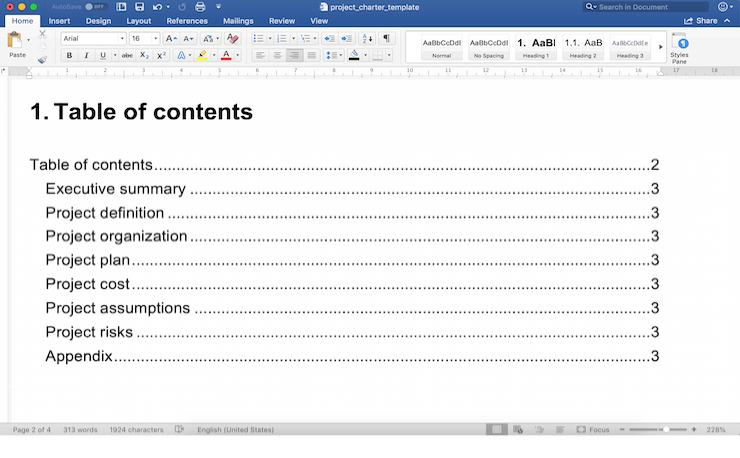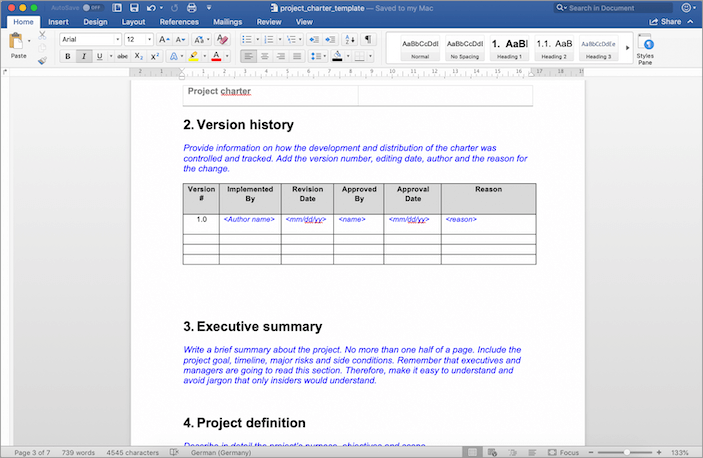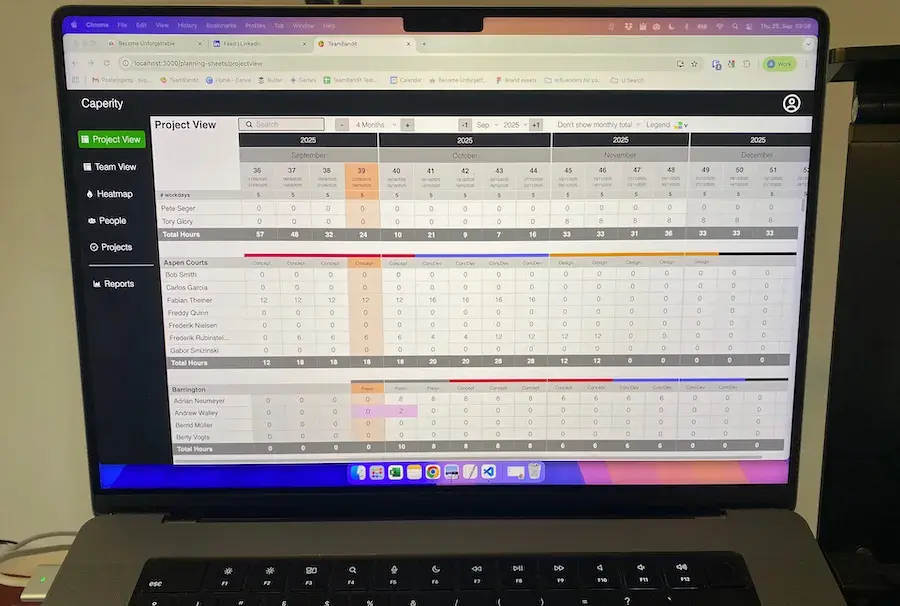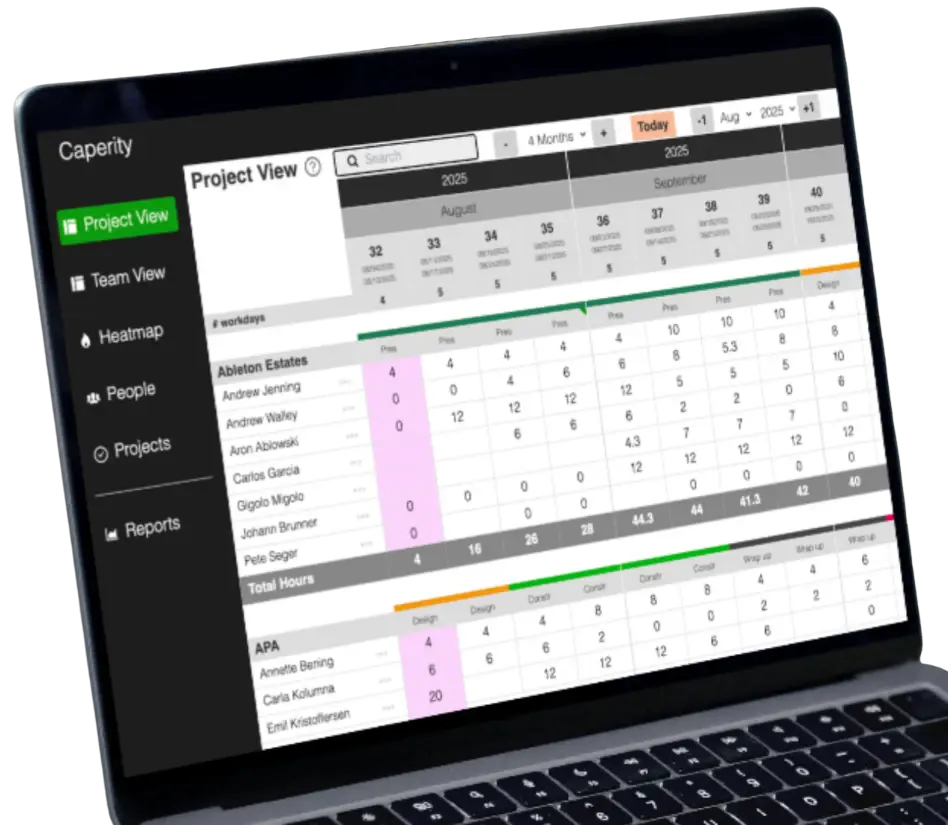The template can be used for any project. It is simple, clear and and contains all parts that go into a project charter, including scope, objectives and project risks. You can download the template here.
Why a project charter is a good thing
Projects are like monsters. They are complex, risky, and require tons of effort to complete succesfully. The only thing that can tame them is the structure you build around a project: The project plan, a project organization with clear responsibilities, a communication plan and so on.
This structure would be worth nothing if it weren’t documented anywhere. Like in a contract that summarizes the points that were agreed at the outset.
This is where the project charter comes into play. A project charter is a document that states in clear terms the why and how of a project: The reason why it was initiated, how it is going to be managed, who’s going to be involved and what it’s responsible for. It sets the boundaries of the project.
Project management tip:
A project charter is like a contract between the customer and the contractor. Always create a charter to make sure both parties have a common understanding of what their rights and responsibilities are.
Why should you create a project charter? For the same reason you use contracts in business and other areas of life. It creates a common understanding of what people get out of the project and how each side is supposed to contribute. Imagine the customer comes to you saying “Oh, I thought you would also do the data migration for us”. You can refer the customer to the project charter, where it might be stated that migration is not in scope. No guessing and no presuming.
With the above said, you’ll understand why a project charter should always be signed by the customer and the party managing the project.
Here you find my project charter template. Let’s take a look at the chapters in the charter.
How to use the Project Charter template

Executive summary:
Write a brief summary about the project. No more than one half to one third of a page. Include the project goal, timeline, major risks and side conditions. Remember that executives and managers are going to read this section. Therefore, make it easy to understand and avoid jargon that only insiders would understand.
Project management tip:
The executive summary is where you should ‘sell’ your project to management. Think about how your project is going to help the company you’re working for. Does it help reduce cost or increase turnover? Does it create competitive advantage? Include these benefits in this section.
Project definition:
This is where you describe in more detail the project’s purpose, objectives and scope.
A project may have one main goal but several objectives. Example: The goal of an IT project could be to upgrade a company’s IT infrastructure. On top of that, it may pursue a few additional objects, such as reducing IT infrastructure cost or speeding up processing times for inbound customer calls.
Objectives may fall into a range of different areas: financial objectives, sales objectives, employment objectives, technical objectives for example.
Naturally, objectives should be defined very clearly. Otherwise it will be difficult to measure success. A great method to define clear objectives is the S.M.A.R.T. method. You want to define objectives that are:
- specific
- measureable
- attainable
- relevant
- time-bounded
(Hence the acronym SMART.)
Here’s an example of a smart objective:
“By deploying new IT infrastructure at our call center, we want to reduce waiting times for inbound customer calls by 30% by end of December .”
Now, onto the next part that should go into the project definition section: project scope.
Describe the work and project deliverables your project has been charged with. Taking the call center project, scope would include: evaluating vendors who sell respective systems, negotiating, choosing a vendor, installing the system and providing training to call center agents to make sure they know how to use it.
Make sure to add a few words on what is out of scope. That is, what the project is NOT responsible for. In the project example, we might exclude the task of redesigning the process how calls are being handled because it’s only a technical upgrade.
You also want to give the reader an idea of the project’s overall impact. Specifically, the processes and areas that are going to be affected. It will be less of a surprise to people once the project is in progress.
Project organization:
Here, you describe the project’s organizational structure. This includes the project roles, departments and people.
What roles were define for the project?. Some roles are common for most projects. For example, there’s always a project sponsor, a project manager and maybe a steering committee.
Other roles are specific to the project. Does your project have a data migration specialist, a software developer, a legal advisor or a training coordinator? Put it in here.
I’m lazy, so I usually just paste a screenshot of the project org chart here. It’s great because one can see the roles, people and reporting lines at one glance.
Project plan:
Add here the project start date, end date and major milestones.
Also, paste a screenshot of the project plan.
Don’t have a project plan yet? Get the project plan template here and create a professional Gantt chart in minutes.
Project cost:
I’ve seen managers skip all other sections in the charter just to read this one. It gives the estimated project cost. Managers care about the financial side more than about anything else.
Include in table form the summary figures: Total budget broken down by year or month and category such as labor, goods and services and travel cost.
Don’t know how to set up a project budget? My article on project budgeting shows the exact steps for creating a project budget (download my budgeting template).
I only add a screenshot of the cost dashboard here (taken from my budgeting template).
Project considerations / assumptions:
Every project is based on certain assumptions. These should also be listed here. It is one of the points that can save your ass later.
Here are some examples of project assumptions:
- Project activities have to be suspended in January due to a trade fair.
- The project is not responsible for checking data quality.
- The company provides capable key users who meet the defined criteria (define those here).
Risks:
What are the major risks that could jeopardize your project? Think of technical risks such as engineering work taking longer than expected. Or resource risks, resulting in people being withdrawn for other projects, leaving you with a project but no team who can do the job. Or it could be quality risks, such as data being corrupted.
This risks section is important because it focuses people’s attention on the sensitive areas. It’s like saying “Here are the things that could mess up the project. If you are involved in any of these areas you better do your job right. Or else.”
Communicating the major risks to the customer and stakeholders also shows that you’ve done your due diligence. Nobody can blame you for not being conscious of risks.
I like to be very clear and honest in my risk assessment.
Appendix:
Here you can include links to project documentation or link to your original project plan, budget and other information.
Final steps and sign off
Review each statement in the charter carefully and eliminate any ambiguity. Whatever is written in the project charter must be absolutely clear and leave no room for interpretation. Let your supervisor or colleague review the content and give you feedback.
Once the charter is ready, send it to the customer for review. Once both sides have confirmed its content, print the charter and have it signed.
Project Charter Template for Word
Download the project charter template here as doc file for Word.

Buy the project charter template
Author
-
Hi, I’m Adrian, a Senior Project Manager and the Creator of Tactical Project Manager, where I teach a pragmatic approach to project management. Led large-scale IT and business projects for over 10 years. My goal is to enable you to lead any project with confidence.
View all posts



